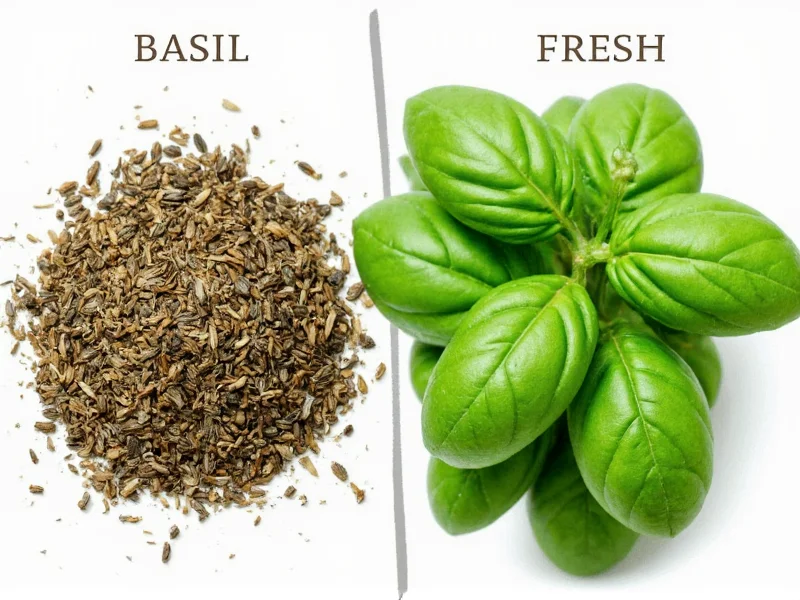Understanding the Fundamental Differences
When comparing dried basil versus fresh basil, the most immediate distinction lies in their moisture content. Fresh basil contains approximately 92% water, giving it a vibrant green color and delicate texture. Drying basil removes this moisture, concentrating certain compounds while diminishing others. This transformation creates two distinct ingredients that, while related, serve different purposes in the kitchen.
Flavor Profile Comparison
The flavor difference between dried and fresh basil is substantial. Fresh basil delivers a complex profile with sweet, anise-like notes, subtle pepperiness, and hints of mint. Dried basil, by contrast, develops earthier, more muted characteristics with less of the bright top notes. The drying process breaks down some volatile compounds while concentrating others, resulting in a more uniform but less nuanced flavor.
| Characteristic | Fresh Basil | Dried Basil |
|---|---|---|
| Flavor Intensity | Mild, bright, complex | Concentrated, earthy |
| Aroma | Strong, sweet, herbal | Muted, woody |
| Best Used In | Raw applications, finishing | Cooked dishes, long simmering |
| Shelf Life | 5-7 days refrigerated | 1-3 years stored properly |
Precise Substitution Guidelines
Understanding dried basil substitution for fresh basil ratios prevents recipe disasters. The standard conversion is 1:3—meaning one teaspoon of dried basil equals one tablespoon of fresh. However, this ratio isn't always perfect due to flavor degradation in dried herbs. For optimal results when substituting dried basil for fresh:
- Reduce the amount by 25% if the dried basil is older than 6 months
- Add dried basil early in cooking to allow flavor development
- Add fresh basil at the end of cooking to preserve delicate flavors
- For pesto, never substitute dried for fresh—the texture and flavor profile won't work
Culinary Applications: When to Use Each
Knowing when to use dried basil instead of fresh makes a significant difference in your cooking results. Fresh basil shines in applications where its delicate flavor and texture can be appreciated:
- Caprese salads and sandwiches
- Pesto and other raw herb sauces
- Garnishing finished dishes
- Summer pasta dishes with tomatoes
- Cocktails and infused waters
Dried basil performs better in situations requiring longer cooking times:
- Tomato-based pasta sauces simmered for 30+ minutes
- Stews and braises
- Dry rubs for meats
- Herb blends like Italian seasoning
- Bread doughs and baked savory items
Storage Methods and Shelf Life
Proper storage significantly impacts the quality of both forms. For fresh basil:
- Treat like cut flowers—place stems in water at room temperature
- Never refrigerate unless wrapped in a damp paper towel inside an airtight container
- Use within 5-7 days for peak flavor
For dried basil:
- Store in airtight containers away from light and heat
- Keep away from strong-smelling spices that can transfer odors
- Replace every 1-2 years for optimal flavor (though safe indefinitely)
- Test potency by rubbing and smelling—if aroma is weak, it's time to replace
Nutritional Comparison
While both forms offer similar nutritional profiles, the drying process affects certain compounds. Fresh basil contains higher levels of vitamin C and some volatile compounds that diminish during drying. Dried basil has more concentrated levels of certain antioxidants and minerals due to water removal. However, since you use smaller quantities of dried basil, the actual nutritional difference in typical servings is minimal.
Common Mistakes to Avoid
Cooks frequently make these errors when working with dried basil versus fresh basil:
- Using equal volumes when substituting (remember the 1:3 ratio)
- Adding dried basil at the end of cooking (it needs time to rehydrate and release flavor)
- Using dried basil in raw applications (results in unpleasant texture)
- Storing fresh basil in the refrigerator without protection (causes blackening)
- Assuming older dried basil has simply "lost flavor" rather than developed off-flavors
Preserving Fresh Basil
If you have an abundance of fresh basil, proper preservation maintains quality. The best methods include:
- Freezing whole leaves in olive oil in ice cube trays
- Creating basil pesto and freezing in portions
- Drying using a food dehydrator at low temperature (115°F/46°C)
- Never sun-dry basil as this destroys delicate flavor compounds











 浙公网安备
33010002000092号
浙公网安备
33010002000092号 浙B2-20120091-4
浙B2-20120091-4